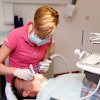
Some conditions can make people reluctant to show their smiles, such as tooth discoloration, missing teeth, and gingival hyperplasia, an overgrowth of the gums. Gingival hyperplasia affects not only aesthetics, but it also causes discomfort, alters one's speech, and hinders chewing. Certain medications, commonly referred to as the "three C's," are known to induce gingival hyperplasia: calcium channel blockers, cyclosporine, and anticonvulsants.
Calcium channel blockers
 Teresa Mendoza, PharmD.
Teresa Mendoza, PharmD.
Calcium channel blockers (CCBs) are commonly prescribed for hypertension, angina, and arrhythmias. They can be divided into two classes: dihydropyridine (DHP) CCBs (e.g., amlodipine and nifedipine), which primarily cause vascular dilation; and non-dihydropyridine (non-DHP) CCBs (e.g., verapamil and diltiazem), which have effects on the heart.
DHP CCBs have a higher incidence of gingival hyperplasia than non-DHP CCBs, with only diltiazem having postmarketing cases. It is suggested that gingival hyperplasia occurs due to an accumulation of collagen fibers without proper degradation.
Cyclosporine
Cyclosporine is an immunosuppressant approved for preventing organ rejection post-transplantation and treating autoimmune conditions such as psoriasis and rheumatoid arthritis. This medication works by inhibiting T-lymphocytes, thus reducing the immune response.
While it is effective, up to 90% of patients taking cyclosporine develop gingival hyperplasia. Although the exact mechanism is unknown, it is believed to result from factors like extracellular matrix molecule synthesis and degradation, inhibited collagen phagocytosis, and fibroblast proliferation.
Anticonvulsants
Phenytoin is the most common anticonvulsant linked with gingival hyperplasia. It is a sodium channel blocker that reduces the neurons' firing rate to prevent seizures.
About half of patients taking phenytoin experience gingival hyperplasia, usually within one month of initiation. The pathogenesis of phenytoin-induced gingival hyperplasia is believed to involve an interaction between the drug and fibroblasts, resulting in decreased collagen degradation and fibroblast apoptosis. There is preliminary evidence that other anticonvulsants, such as lamotrigine, oxcarbazepine, and phenobarbital, may also lead to gingival hyperplasia.
Conclusion
Gingival hyperplasia is a reversible condition if the medication causing it is discontinued. When necessary, referral to a periodontist for treatment is an effective option.
Dentists must be proactive in asking thorough questions about a patient's medication use, recognizing the signs of gingival hyperplasia, and understanding the medications that might be responsible. The Digital Drug Handbook, a novel online medication resource built for dentists by dentists, can be an invaluable tool, saving time and easily identifying oral side effects. Equip yourself with the knowledge and tools to ensure the best care for your patients.
Teresa Mendoza, PharmD, received her degree in biochemistry and a minor in Chicano/a studies from the University of California, Los Angeles (UCLA). She earned her Doctor of Pharmacy degree from the University of California, San Francisco School of Pharmacy. Mendoza has held many executive positions involving service to the community and higher education advocacy. She is a contributor to MedAssent DDS as a medical/pharmaceutical communications specialist, where she leads the blog, white paper, and continuing education content.
Dr. Lisa Chan has devoted her career to promoting equity in care in both dentistry and her community. She brings over 35 years of diverse experience in dentistry to her role. Chan received her Doctor of Dental Surgery degree from the University of Southern California Herman Ostrow School of Dentistry. Her background includes significant positions such as a hospital dentist at Kaiser Permanente, a private practice dentist in Los Angeles, and a consultant for the California State Dental Board. Chan co-founded MedAssent DDS with the mission of elevating patient safety through integrated care.
The comments and observations expressed herein do not necessarily reflect the opinions of DrBicuspid.com, nor should they be construed as an endorsement or admonishment of any particular idea, vendor, or organization.




















